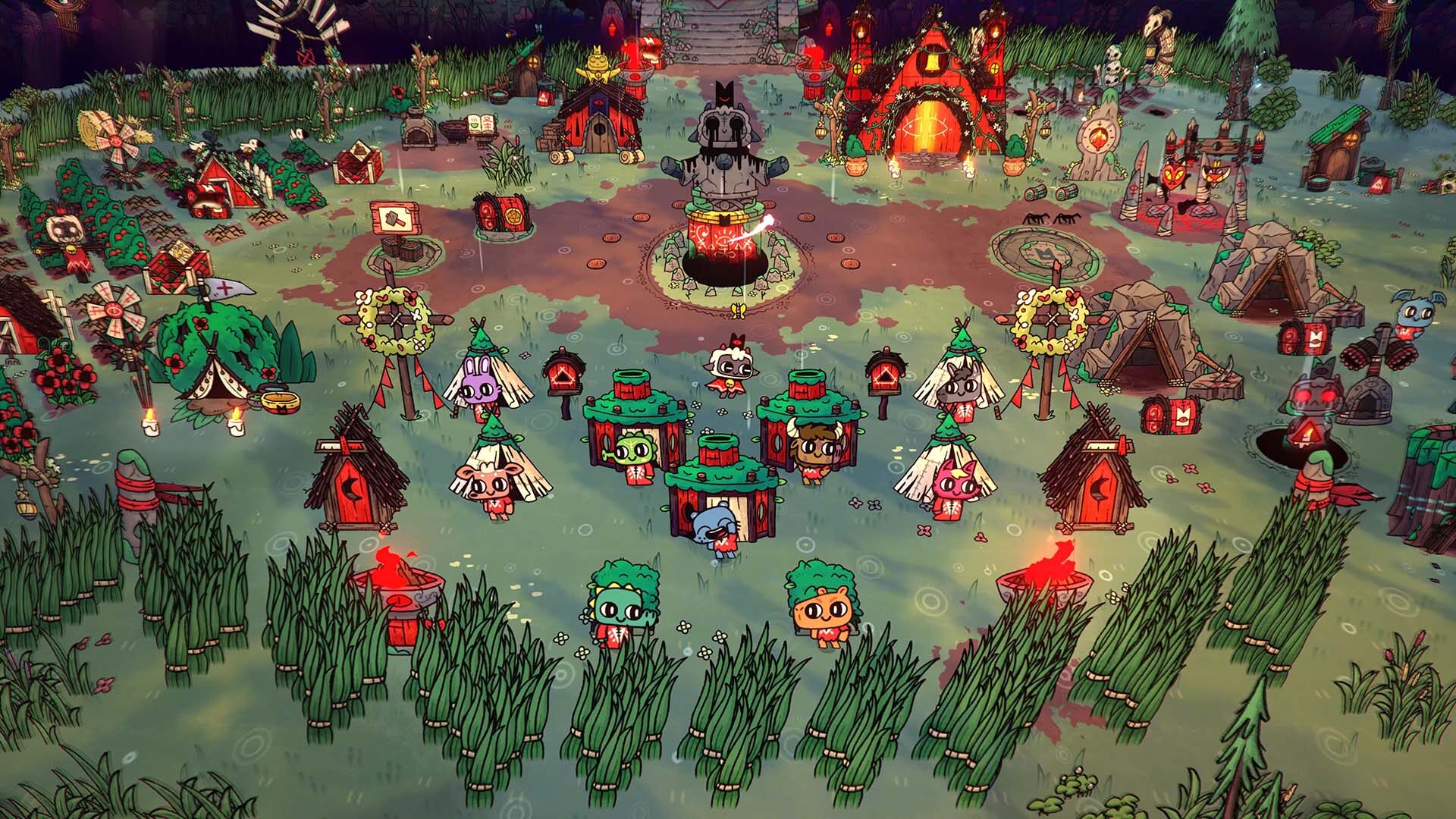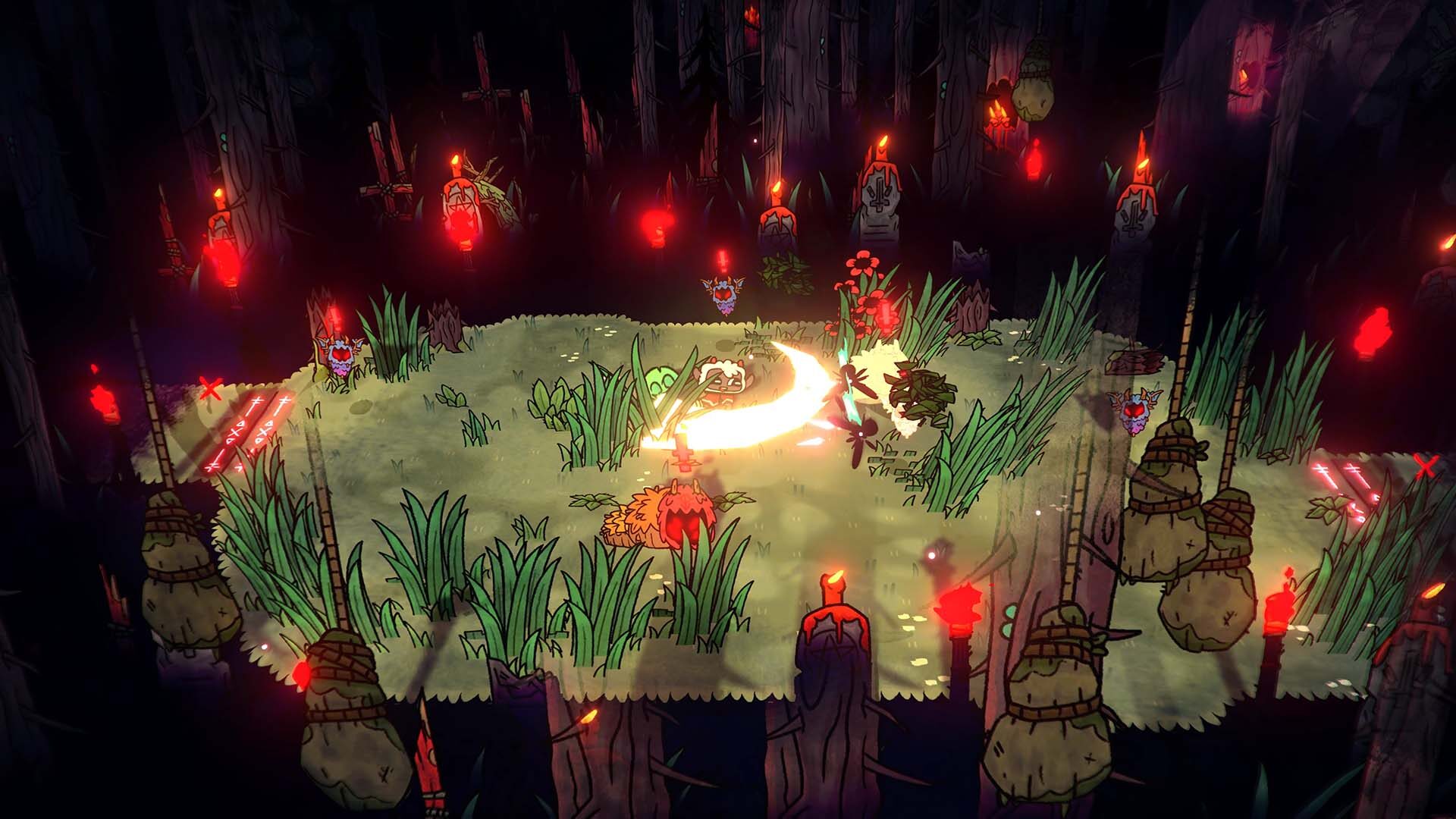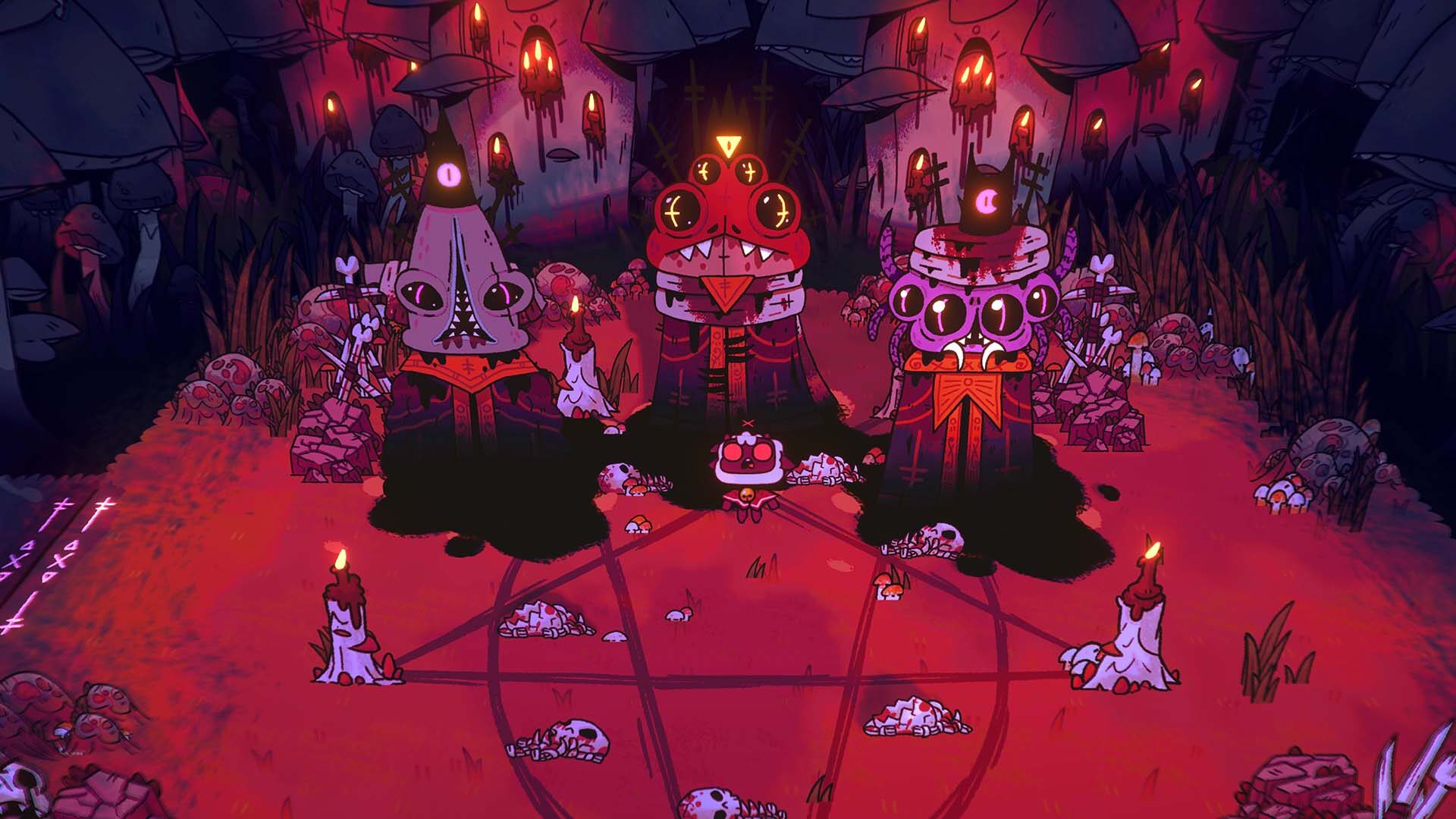It’s been a long time since I’ve been properly obsessed with a game. The older I get, the more precious my time on this Earth starts to seem. Viewed through that lens, even when I am professionally obligated to play a game, I usually find them pretty easy to put down. That was not the case with Cult of the Lamb, a game that kept me awake past 2 a.m. more than once while I was reviewing it.
Cult of the Lamb is the epitome of the game that makes you say, “Just one more round.” Structured around a perfectly metered out day-night cycle, the game lulls you into a rhythm. In the morning, you feed your cult before your daily worship. By midday, everyone is hard at work gathering resources and generating devotion. In the evening, you can roll through your camp, collecting the fruits of your cult’s labor. Then it’s bedtime, giving you a moment to tie up some loose ends while your cult members sleep peacefully in their tents—or on the cold, wet ground, if you’re that kind of cult leader.
As I stated in my preview, Cult of the Lamb’s cutesy aesthetic doesn’t merely lend irony to the darker themes of demonic worship and religious brainwashing (not that those themes are ever really developed throughout the game). Instead, Massive Monster’s adorable art style is an effective tool at getting you to almost immediately care about the members of your cult. I wanted them to live their best lives and I needed them to love me, not for any reason other than that they were so darn cute. And, as if they were Pokémon, I wanted to catch them all.
I loved my little cult so much that I didn’t want anyone to leave. I didn’t want anyone to stray. So I built better tents for them to sleep in. I planted better food for them to eat. I did everything they asked me to do, even if that meant imprisoning another cult member for stealing. Besides, I usually let the prisoner go after a day and gave them a consolation gift of a homemade necklace just to say, “No hard feelings.” I danced with them, paid them, gave them weekends off, and every once in a while we all tripped balls together. If I left them for too long while I was out slaying heretics, I made sure to reward their patience with a feast. All I asked for in return was their devotion, their labor, their bodies just for the occasional demonic possession, and, when the time came, their lives.

Then it was over. I slayed all the heretics. My duty was done. I was left feeling empty. What was my purpose now? What was the point of any of it? Sure, you could say that about a lot of games, especially ones that don’t have particularly engaging stories. But this time I felt worse, like I was waiting for something that never showed up. While there was definitely more of everything that I liked about Cult of the Lamb when I previewed it, the game didn’t get more interesting. Sure, I was adding a bunch of buildings and unlocking new rituals and gaining new followers, but all the game did was expand. It never deepened.
This feeling of expansion over depth could have something to do with the fact that Cult of the Lamb is basically two games in one. The first game is a cult management sim where you do all the fun stuff I mentioned earlier, like farming and delivering sermons. The second game is a 2D roguelike where you have to fight your way through randomly generated, enemy-filled rooms with randomly assigned weapons until you either beat a boss or die. While there’s the slightest hint of a story driving you towards your goal, the real motivation is to gather resources and followers while you’re slaying heretical unbelievers of The One Who Waits.
Cult of the Lamb’s combat is easy—maybe a little too easy, at least on the “medium” difficulty setting. I only died once throughout my entire time with the game, and this is coming from someone who barely made it through one successful run of Hades. Part of that could be how quickly and efficiently I leveled up my cult (more on that later), but I do think that Cult of the Lamb is not meant to be a terribly difficult game. There are only a handful of enemy types in each of the four combat zones, and while a lot of them are unique to their specific zones, they tend to have similar attacks.
The list of weapon types offered is also relatively short. There’s a dagger, a sword, an ax, a hammer, and gauntlets. While each of these can have their own passive perks (like poisoning enemies or spawning a spirit from a dead enemy that will attack another enemy), using them essentially feels the same. The only weapon that felt totally unique was the hammer, which had a long wind-up time but a devastating delivery. It was easily my favorite weapon in the game, as you have to time your attacks more than with the others.
Curses are the other tool you get to help you dispose of your foes. These are essentially magic attacks that use a mana pool, which you have to recharge by killing enemies. Like the weapons themselves, there are only a handful of curses in the game, though the effects that they can have also change. One curse, for example, is just a powerful sword attack, though you can get a sword attack that spawns spirits or one that freezes enemies. While the curses genuinely feel different from one another, there also aren’t that many of them.
If it sounds like I found the combat in Cult of the Shadow to be shallow, that’s because I kind of did, but that also doesn’t mean I didn’t enjoy it. For one, there are tarot cards that you can unlock and randomly receive during your combat runs that will give you temporary buffs, and those can have an impact on how you play or at least how strong you feel. You can also unlock a structure at your camp that lets you temporarily turn your followers into demons and follow you into battle. Experimenting with these elements can be fun and add variety to your playthrough.

The main reason I enjoyed Cult of the Lamb’s combat, however, was because of its context. Venturing out into the wilderness to murder heretics had meaning because I was doing it in the service of my cult. It helped break up… I don’t want to say the “monotony” of managing my cult, but it lended a nice rhythm to my time with the game. I’d spend a few days at the camp, amassing wealth and resources, and earning my cult’s devotion, and then head out for a heretic-slaying adventure. But more than that, I wasn’t just killing enemies for myself. I was killing enemies so I could bring goods back to my loyal followers.
There’s a satisfying synergy between the two halves of Cult of the Lamb. The bones I earned from killing my enemies could be spent on rituals back home. These rituals could make my cult followers happier, more productive, or more devoted. The more devotion (an actual resource in the game) they gave me by praying to the camp’s central idol, the more I could level up the camp by unlocking new buildings like farms and mines. The more items I farmed and mined, the more gold I could earn, which I could then spend on tarot cards, or turn into gold bars which I would use to build more advanced versions of mines, camps, and more.
In this way, Cult of the Lamb’s systems feed into each other nicely, but just like combat, the cult management aspect just felt too easy. About halfway through my time with the game, I already had more resources than I would ever really need. I never ran out of wood or stone or food, and if I ever got low on gold, I could just sell whatever excess mushrooms or materials I had. The game’s economy felt broken, and as someone who never really engages too deeply with these kinds of systems in similar games, I found it strange how easy it was for me to basically never have to worry about resources.
On the other hand, there were other ways in which Cult of the Lamb seemed a little too user unfriendly. One of the main concerns is whether or not your camp is clean and sanitary, as your followers need to defecate and occasionally vomit. One of the solutions is to build a janitor’s closet, which will randomly assign a cult member to clean the mess. The other solution is to give your followers a place to do their business in the form of an outhouse. The problem with the outhouses is that they can fill up and overflow, so you have to occasionally clean them (which, conveniently, nets you some fertilizer to use on your farms). Now, you’d think that the janitor would also clean out the outhouse and deposit the fertilizer in the specific dumpster next to the farm that’s designated for storing fertilizer. But the janitor seemingly ignores whatever mess accumulates at the outhouse, leaving you to constantly be checking them.
This is just one example where Cult of the Lamb’s management sim half feels lacking. Followers assigned to farms, as another example, won’t wait until the crops are fully grown, thus netting you seeds that you can then turn into more plants. Instead, they’ll pick them just early enough that you miss out on that added bonus. If the idea is to have your cult working for you, then why did I feel like I was constantly doing the dirty work? Then there’s the fact that you can’t move or remove buildings once you’ve placed them, which was aesthetically annoying but not necessarily game-breaking. Ultimately, the management side of the game, while compelling and expansive, did end up feeling a bit shallow, too.
It might sound like I have a lot of complaints about Cult of the Lamb, but the fact of the matter is that it didn’t really stop me from enjoying my time with the game any less—except for having to clean the outhouses constantly. But just because something is a little shallow doesn’t mean it can’t be fun. As I write this review, the latest season of the British reality show Love Island is airing in the U.S. Like the followers in my cult, its contestants are all trapped on a small plot of land, performing the same tasks (in this case, “grafting” and toe-sucking) over and over again. Sometimes they play games, but winning doesn’t usually get you anything. The rest of the time, the contestants—who are all influencers or models of some kind—lounge around a pool.
And you know what? I love it. It’s one of the shallowest, most repetitive shows I’ve ever seen, but it’s also one of the most fun shows on TV. Sometimes dumb, shallow fun is exactly what you need, even if that means it isn’t exactly the most fulfilling experience. I don’t always want to have to make an effort. Sometimes I just want something easy to obsess over. Maybe I just want to be brainwashed, too.

|
★★★★☆
Cult of the Lamb is two games in one. Part roguelike, part management sim, neither of the halves feel totally fleshed out on their own, and provide little challenge. Still, the synergy between the two halves is undeniably compelling, and the art style is infectiously adorable, giving you enough reason to play through one more in-game day, and then one more, until you’ve been awake for an entire out-of-game day, feeling totally brainwashed. |
Developer Massive Monster Publisher Devolver Digital ESRB T - Teen Release Date 08.11.22 |
| Cult of the Lamb is available on Xbox Series X/S, PlayStation 5, Nintendo Switch, Xbox One, PS4, and PC. Primary version played was for PC. Product was provided by Devolver Digital for the benefit of this coverage. EGM reviews on a scale of one to five stars. | |

Michael Goroff has written and edited for EGM since 2017. You can follow him on Twitter @gogogoroff.